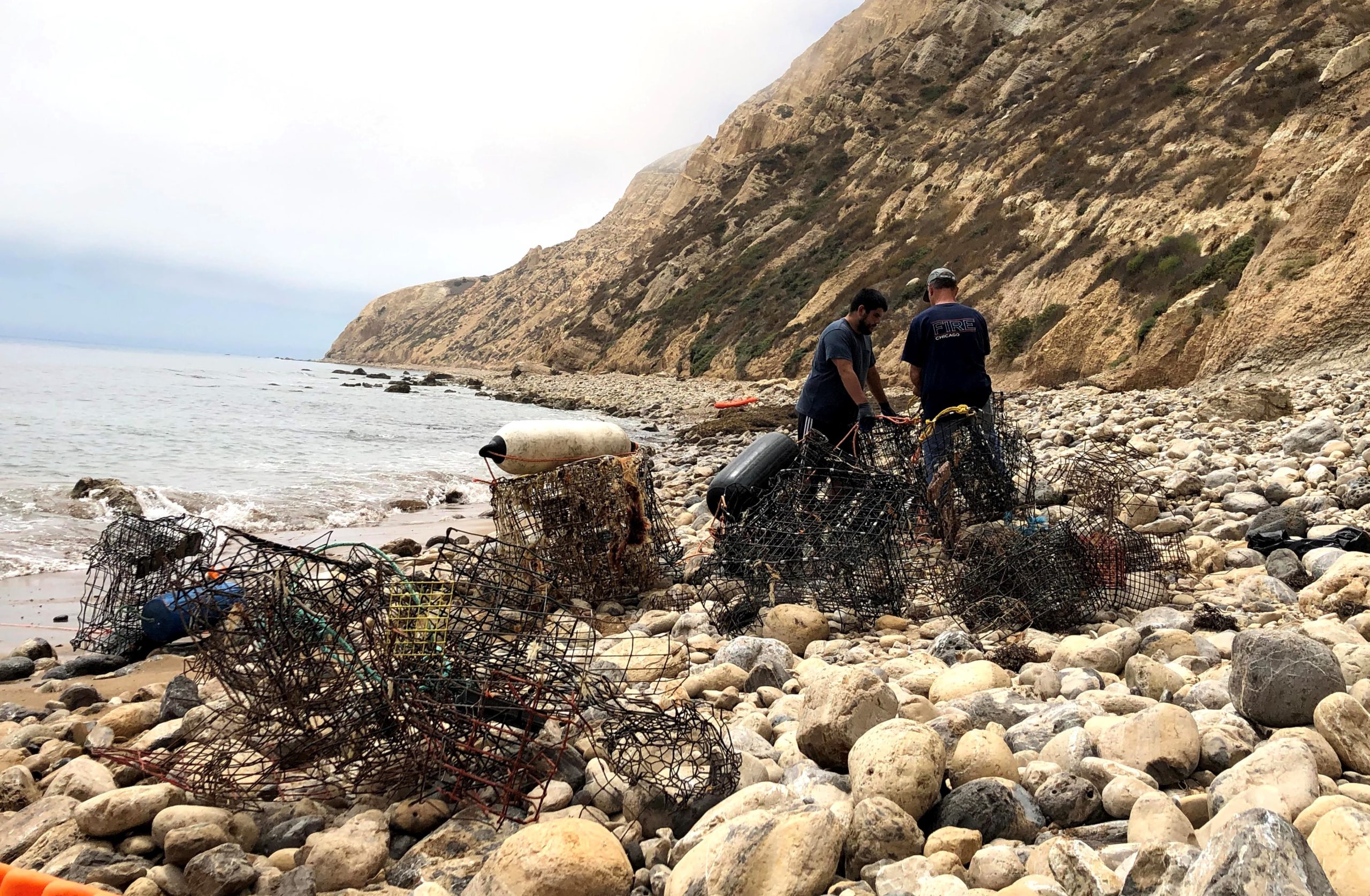
Shoreline cleanup program intends to prevent marine debris from harming ecosystems and wildlife above and below the waterline
First Channel Islands cleanup with local lobstermen and nonprofit partners removed 6,440 pounds of trash from a one-mile stretch of beach on Santa Cruz Island
Silver Spring, Md. – August 28, 2020 – The National Marine Sanctuary Foundation expanded its Goal: Clean Seas initiative to the west coast in Channel Islands National Marine Sanctuary with a successful first cleanup on July 30-31.
The Foundation’s new Goal: Clean Seas Channel Islands initiative will engage local partners and commercial lobstermen to remove marine debris, including lost traps, fishing gear, and trash from Channel Islands National Marine Sanctuary and Channel Islands National Park lands; develop opportunities and partnerships to address shoreline marine debris in the sanctuary; and implement education and outreach efforts to promote awareness and prevention of marine debris.
Goal: Clean Seas Channel Islands is based on the successful Goal: Clean Seas Florida Keys program, a collaboration with Florida Keys National Marine Sanctuary and Blue Star dive operators established in 2018 to remove underwater marine debris and educate the public about marine debris prevention.
Shannon Colbert, Policy and Conservation Director of the National Marine Sanctuary Foundation, said, “Goal: Clean Seas is part of our commitment to protect our amazing sanctuaries from marine debris that harms wildlife and habitats, while empowering energetic ambassadors for ocean conservation. We are excited to bring this successful model to the west coast and work with our partners in the Channel Islands to continue this great work.”
Goal: Clean Seas Channel Islands kicked off with a two-day marine debris cleanup on July 30 and July 31, 2020. On Santa Cruz Island, two local Santa Barbara veteran commercial lobstermen, Santa Barbara Channelkeeper, and their crews removed marine debris off the shoreline. The lobstermen devised an ingenious system with their vessels’ hydraulic pulley to retrieve heavy debris from the shore. Over the two days, the 18 cleanup participants successfully removed 6,440 pounds of trash from a one-mile stretch of beach known as Yellowbanks. All debris was transported back to the mainland and deposited into a dumpster back at the Santa Barbara Harbor for sorting and recording of debris. Most of the debris recovered consisted of 131 lost lobster traps, the majority of which looked to be four years or older, before the California Department of Fish and Wildlife’s trap tagging program was implemented. Recovered trap tags were reported to the California Department of Fish and Wildlife to be catalogued. Other debris collected and disposed of included foam fishing buoys, rope, and miscellaneous plastics.
The cleanup of marine debris in the sanctuary is important to protecting the wildlife that live there. The endemic island fox sometimes forages along the shorelines of the Channel Islands. Pinniped species, such as California sea lions and Pacific harbor seals, haul out along the shorelines of Santa Cruz Island.
Goal: Clean Seas Channel Islands builds on 20 years of shoreline cleanups on the northern Channel Islands facilitated by Channel Islands National Marine Sanctuary on an ad hoc basis with partners including the University of California-Davis California Lost Fishing Gear Recovery Project, California State University-Channel Islands, and the National Park Service. These were conducted more systematically in partnership with local commercial lobstermen since 2016, when the California Spiny Lobster Trap Loss Prevention and Recovery Project was funded through a NOAA Marine Debris Program grant. This project, developed with the guidance of local veteran lobstermen Sam Shrout, Chris Voss, and Jim Colomy, identified key best fishing practices to reduce the loss of lobster traps within the fishery and minimize the impacts of lost lobster gear.
By collecting long-term data, continuing the important partnership with commercial lobstermen in yearly cleanup efforts, and expanding opportunities and partnerships to address marine debris in Channel Islands National Marine Sanctuary, the Foundation’s new Goal: Clean Seas Channel Islands initiative aims to establish a lasting, self-sustaining marine debris removal program.
Goal: Clean Seas Channel Islands is hosting a second cleanup in September in association with the California Coastal Cleanup month.
Channel Islands National Marine Sanctuary, one of 14 in the national marine sanctuary system, is a diverse habitat off the coast of Southern California’s Santa Barbara and Ventura counties featuring endangered species protection, innovative research and conservation, world-class outdoor recreation, award-winning learning and volunteer programs, and archaeological remains. The sanctuary encompasses approximately 1,470 square miles (or 1,110 square nautical miles) of exceptional natural beauty and resources in the ocean waters surrounding Anacapa, Santa Cruz, Santa Rosa, San Miguel, and Santa Barbara Islands.
Goal: Clean Seas Florida Keys continues to operate in 2020 with new cleanup dives conducted by Blue Star dive operators. In its first year, National Marine Sanctuary Foundation-funded divers conducted 49 cleanup trips, engaged 450 volunteer divers, and spent nearly 900 hours underwater removing 78 intact lobster traps, hundreds of pieces of lobster trap debris, 16,369 feet of line, and 14,693 pounds of debris from Florida Keys National Marine Sanctuary. For more information on Goal: Clean Seas Florida Keys, visit: https://marinesanctuary.org/goalcleanseas/.
Contact: Chip Weiskotten
Director of Strategic Communications
301.608.3040 x 305
chip@marinesanctuary.org
###
The National Marine Sanctuary Foundation, established in 2000, is the official non-profit partner of the National Marine Sanctuary System. The Foundation directly supports America’s national marine sanctuaries through our mission to protect species, conserve ecosystems, and preserve America’s maritime heritage. We accomplish our mission through community stewardship and engagement programs, on-the-water conservation projects, public education and outreach programs, and scientific research and exploration. The Foundation fosters innovative projects that are solution-oriented, scalable, and transferable, and develops strategic partnerships that promote the conservation and recovery of species and their habitats. Learn more at marinesanctuary.org.
